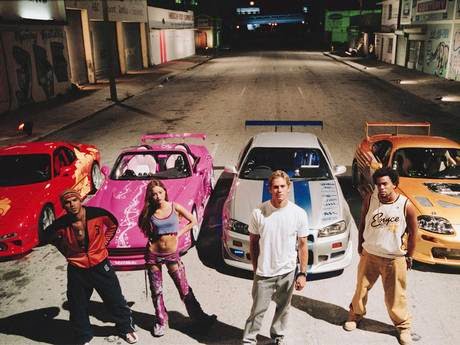Please. I’ve tried to do away with the whole “let’s like
that but only ironically because otherwise other people might sneer at us”
attitude because I’d rather be sincere about my cultural tastes than feel
obliged to have endless chin-stroking conversations about Wes Anderson’s colour
palettes.
So, it
follows that I take offence when people ask me if my love of the Fast and Furious franchise is a “guilty
pleasure”. NOPE. This, for the pretend-ignorant, is the gas-guzzling,
car-centric action film series, starring Vin Diesel and the late Paul Walker,
whose seventh instalment hits cinemas this week.
Given
that critics usually consign the films to the realm of boy-racer fantasies,
many find this 32-year-old woman’s intense love for their majesty difficult to
understand. But while I might not be their target audience, I am an audience
member nonetheless, and one whose deep-rooted love for action movies makes me
evangelical in my defence of them – for, make no mistake, FaF is too good to be
left to the teenagers. Don’t believe me? Fine. As Dom Toretto, Diesel’s
reluctant hero might say, let me give you a reason to stay…
A key part of
its appeal was the chemistry between its two leads, Diesel’s street race gang
leader Toretto and his clean-cut adversary, Walker’s undercover FBI agent Brian
O’Conner. We saw O’Conner switch sides, notionally as a result of falling in
love with Toretto’s sister, Mia, but it was clear from the first rev that
bromance was the real driver.
An unexpected
hit, it prompted inevitable sequels:2Fast2Furious,
which erroneously lost Diesel, and the third,Tokyo
Drift, which moved to the Far East with a completely new set of leads. The
latter was a gamble that didn’t pay off – like any sequel that effectively
starts all over again, it lost fans who didn’t want to invest in a new
“family”. It was the worst box-office performer of the series so far, and it
felt, even to die-hard fans like me, like the series might be running out of
NOS gas.
And lo, a decade
into existence, the series accelerated into top gear. Fast Five took us to Rio, and introduced
the one actor that could elevate the franchise even further – Dwayne “The Rock”
Johnson. His inclusion in this movie as a DEA agent pitted against Toretto’s
crew not only raised the stakes for our gang of anti-heroes but also meant we
got to see Riddick fight The Scorpion King, in a showdown that was action movie
fans’ very own “Rumble in the Jungle”.
Fast Five also featured one of the greatest car
chase scenes ever committed to film – a sequence involving a bank vault that
was only topped by the finale of Furious 6, in which the gang tried to stop a plane
taking off what seems to be an infinite runway by, essentially, using cars as
weights. The sixth Furious also
provided an extra adrenaline rush for British fans by travelling to London for
a late-night race across Piccadilly Circus – as if it has ever been that empty
– and paved the way for Furious 7, in an ingenious post-credits scene that had
the cinema I was in on its feet, whooping in delight. You didn’t get that with The Grand
Budapest Hotel.
But, for
unmitigated thrill value, FaF is untouchable. I’d love to discover other movie
franchises that feel as fresh, as exciting and as entertaining as this one at
the seventh instalment. SEVEN, for goodness sake. Police Academy made it, but the less said about
Mission to Moscow, the better. FaF has also succeeded where so many other
Hollywood blockbuster franchises fail – in the art of reinventing itself,
whilst remaining true to its roots. So the fifth and sixth instalments
effortlessly took on the mechanics of a heist movie, while sending the leads
trotting the globe in the style of James Bond or Jason Bourne.
Most excitingly,
and unlike most other franchises out there, however, FaF isn’t working to a
blueprint: unfettered by source material, it can career wherever it wants. And
now, seven films in, the series has even acquired some emotional gravitas,
following the untimely death of Walker last year. It’s a tragedy that hangs
over Furious
7; Walker died halfway through shooting, and a seamless mix of body
doubles and CGI trickery were employed to finish his scenes.
In terms of set-pieces, Furious 7 has stepped it up yet again – and
that’s not to mention the addition of Jason Statham, as the resident evil. (Did
I really say there was only one actor who could elevate the series further?)
But it’s the manner in which it sends off Walker that makes it linger in the
memory. No spoilers, but let’s just say Furious 7 is
this year’s first great weepie.
Now, even the
critics have warmed to it: at the time of writing,Furious
7 has an 89 per cent
rating on Rotten Tomatoes. It finally feels as if everyone might be catching on
to what us FaF heads have known from day one – that this will eventually be
recognised as one of the best franchises of all time. And about time, too. To
quote Toretto: Salute, mi familia. Here’s to
Number 8.




No comments:
Post a Comment